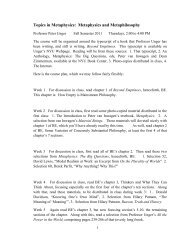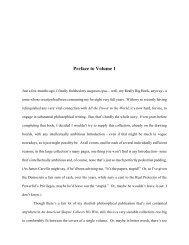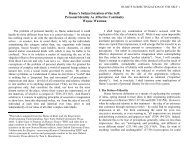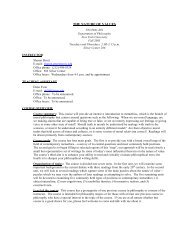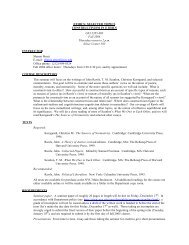1 Rough Equality, Rougher Inequalities, and the 'Jostlings of ...
1 Rough Equality, Rougher Inequalities, and the 'Jostlings of ...
1 Rough Equality, Rougher Inequalities, and the 'Jostlings of ...
Create successful ePaper yourself
Turn your PDF publications into a flip-book with our unique Google optimized e-Paper software.
thought <strong>the</strong>re was nothing intrinsically wrong with sex or having a female body. Whileher Rights <strong>of</strong> Woman issued some warnings about <strong>the</strong> dangerous moral <strong>and</strong> physicalconsequences <strong>of</strong> pre-marital (hetero- or homo-) sexual behavior, especially for childrenor early adolescents, she had a generous view <strong>of</strong> <strong>the</strong> gender roles we might play insociety. For example, she praised <strong>the</strong> famous French transvestite <strong>and</strong> diplomat, CharlesD'Eon, as a woman who "acquired courage <strong>and</strong> resolution" from "from having received amasculine education."Wollstonecraft <strong>of</strong>ten spoke <strong>of</strong> <strong>the</strong> "sober pleasures" <strong>of</strong> rational thought <strong>and</strong>philosophy, while always insisting that <strong>the</strong>se pleasures suited <strong>the</strong> sexless minds <strong>of</strong> men<strong>and</strong> women alike. Unlike Kant, who has been criticized by feminist philosophers forpositing an "idealized" conception <strong>of</strong> a rational male agent at <strong>the</strong> core <strong>of</strong> his ethical<strong>the</strong>ory, Wollstonecraft's approach to ethics resists such a built-in sex bias. Herphilosophical anthropology <strong>of</strong> human beings specifically accounts for biological sexdifferences across <strong>the</strong> species. She proceeded from <strong>the</strong> naturalistic fact <strong>of</strong> femaleembodiment in her <strong>the</strong>ory <strong>of</strong> <strong>the</strong> girl-child's human development.Like Martha Nussbaum, Wollstonecraft also had a capacious underst<strong>and</strong>ing <strong>of</strong> <strong>the</strong>variety <strong>of</strong> capabilities that define <strong>the</strong> human experience, such as sympathy, love, play,<strong>and</strong> bodily integrity. This rich view <strong>of</strong> <strong>the</strong> physical joys <strong>and</strong> freedoms <strong>of</strong> embodiedhuman life was captured in her Rousseau-inspired account <strong>of</strong> child development: "Everyyoung creature requires almost continual exercise, <strong>and</strong> <strong>the</strong> infancy <strong>of</strong> children...should bepassed in harmless gambols, that exercise <strong>the</strong> feet <strong>and</strong> h<strong>and</strong>s." Although she was morelike Kant in her deontological <strong>the</strong>ory <strong>of</strong> <strong>the</strong> foundations <strong>of</strong> human rights, Wollstonecraftparallels many <strong>of</strong> Nussbaum's views on <strong>the</strong> moral importance <strong>of</strong> conceptualizing humans7



